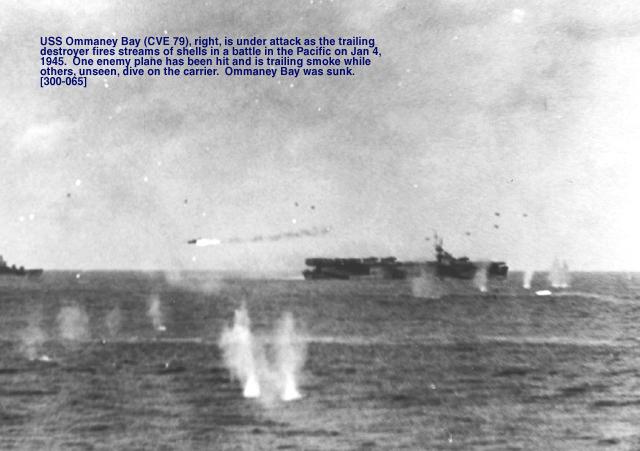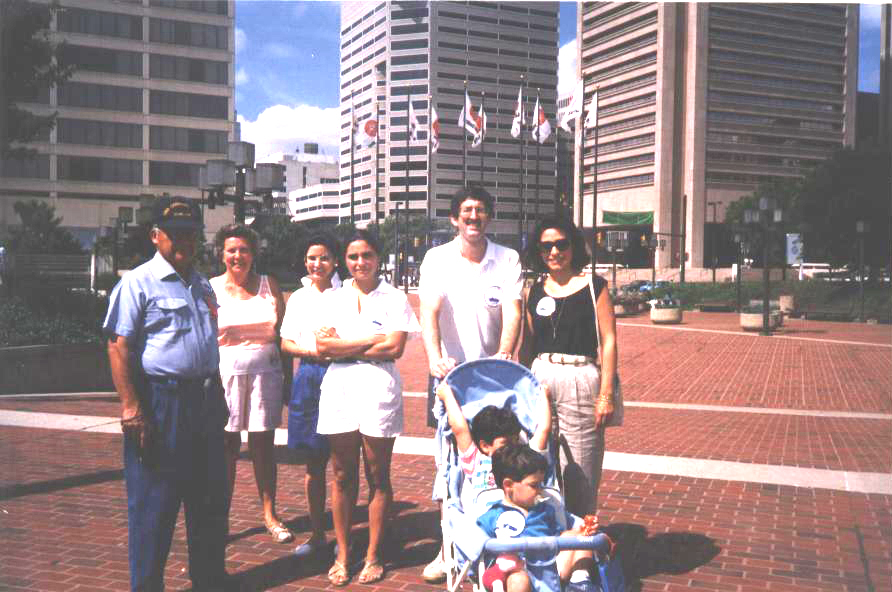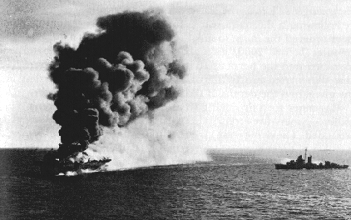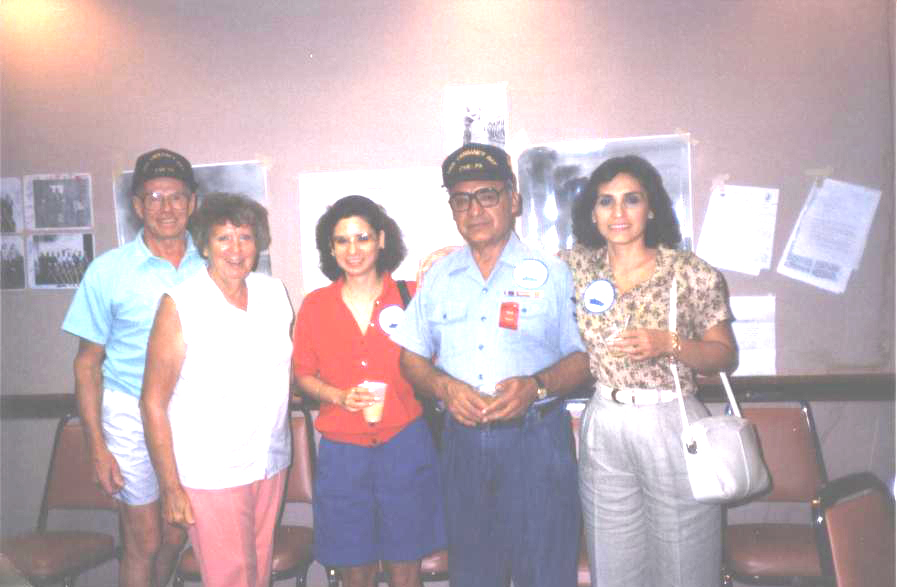USS OMMANEY BAY CVE-79
In Doug MacArthur's Navy
William T. Y'Blood, in THE LITTLE GIANTS, U. S. Escort Carriers Against Japan, published by the Naval Institute Press in 1987, documents the history of the of America's CVE's. He says, "They were called `Jeeps," `baby flattops,' `two-torpedo ships,' `combustible, vulnerable, expendable,' and other, unprintable, names. CVE's was the U. S. Navy's designation for air craft carrier, escort. These ships, envisioned as hardly more than convoy escorts in the beginning, evolved into remarkably versatile vessels. Yes, they were used to escort convoys, but they also hunted submarines, provided air support for invasion forces, ferried men and planes to far-flung bases, delivered replacement aircraft and pilots to the fast carriers of Task Forces 58 and 38, and worked as troop transports. Despite the great activity of the eighty-six vessels built (some finished after the war) to serve all around the world for the United States Navy; their accomplishments, except for one glorious action in October 1944, have never received the publicity and credit that they deserve.
This lack of recognition may have frustrated or even angered the `jeep' sailors, but it didn't stop them from doing their jobs and doing them well.
History has shown that the fast carriers didn't win World War II; neither did the Army Air Forces nor Army or Marine troops. It was a team effort that won the war, and a vital part of this team effort was the escort carriers. Until now, little has been written about their accomplishments, this book is intended to give the CVE's and their sailors their long-overdue attention."
The following were the CVE Operations in the Pacific:
1. Solomon Islands, Aug 1942 - July 1942
2. Attu, May
1943
3. Gilbert Islands, Nov 1943
4. Marshall Islands, Jan-Feb
1944
5. Aitape-Hollandia, Apr 1944
6. Mariana Islands, Jun-Aug 1944
7. Moratai-Anguar-Peleliu, September 1944*
8. Leyte, Oct
1944*
9. Mindoro, Dec 1944*
10. Luzon, Jan 1945*
11. Iwo
Jima, Feb-Mar 1945
12. Okinawa, Mar-Jun 1945
13. Balikpapen, Jul
1945
Typical
WW II Carrier Operations
I re-joined my squadron, VC-75, on the Ommaney Bay, just in time to participate in the Moratai-Anguar-Peleliu operation. My first engagement was the landings in the Peleliu Islands, then followed the Second Battle of the Philippine Sea (Leyte) in October, then the landings at Mindoro Island in December and lastly the Lingayen Gulf landings in January at Luzon where we were sunk. (These are marked with a * above)
We pulled into Manus Island Bay for the Christmas week of 1944. I learned about torpedo juice during that interlude. Torpedo juice is the fuel used by torpedoes after they have been launched from a torpedo bomber. We had several Torpedomen who kept the torpedoes in perfect order. The fuel is pure alcohol. Torpedomen as well as Ordnancemen mix it with orange juice, or pineapple juice and it makes a passable drink. The only thing is the alcohol is tasteless and you do not have a feel for how much is enough. One airman fell off the flight deck of the USS Ommaney Bay while we were anchored at Manus Island. Some people were punished for pilfering the torpedo juice, etc. I was not among those who were punished. I was sick in my rack. A word to the wise, do not drink pure alcohol!
Following New Year's 1945 we pulled up anchor in the dark of
the night and moved out into the Sulu Sea. The next morning, for as far as
the eye could see there were men-of-war (naval vessels) on the horizon.
Some were transports carrying the Army troops that were to land at
Lingayen Gulf, MacArthur's western landing in the Philippines. On January
4, 1945 at 1712 hours, the USS Ommaney Bay received a direct hit by a
kamikaze, i.e. a suicide aircraft, a stripped down twin engine Betty. I
had just returned from combat air patrol. I was hungry and went directly
to the mess hall in the lower decks. Other airmen who were in the flight
went instead to our living quarters in the gallery deck to change clothes.
That was exactly where the suicide hit. The impact knocked out the
electrical power below decks and it was pitch dark in the mess hall. I was
thrown against the bulkhead and got a gash over my right eye. Through our
ingenuity those in the mess hall held hands and we made our way topside.
We finally made it to the fantail on the main deck. There were people
burning all over the place. The Betty had splattered napalm and there were
many severely injured from the blast. Chief Guynes, my boss, was among
them. Chief Wahoo Flores who actually ran flight operations, and on whom
the Ommaney Bay pilots depended to land on deck, died in a fire ball.
Marty Martinez, a promising baseball player and Flores' right-hand man
lost both arms and asked not to be taken off the ship. He preferred to go
down with it rather that to survive and not play baseball. The minor gash
over my right eye brow still bothers me, it itches. The ocean salt water
stopped the minor bleeding and I never went to sick call after we were
rescued. (At 81, in 2007, I have had to have laser surgery to repair a
torn retnia of my right eye.)
My Ship (Home) Under Attack And On Fire - January 4, 1945
 |
There was mad confusion at the fantail. We were pulling survivors out of the water and pulling them back on deck. Communications between the front part of the Carrier, where the Captain had given the order to abandon ship, had been lost and those of us on the fantail had not gotten the word. We learned that the order to abandon had been given from those we fished out of the water. They did not know they were being pulled back on the same ship. The Big O was listing badly but was still underway. Pandemonium broke out. A barber jumped right into the turning propeller screw with a bag of money he kept in the barber shop. All we saw of him was a blotch of red sea water.
I went over the side with a group that included Willard Capistrant. (Whom Dolores, Cissy, Monica met at the Baltimore re-union. Isabel later met him and his wife when they stopped in Albuquerque, on their way through in 1991.)
What we did was unleash one of the big corked nets that hang on the side of all ships. We got it on the water but it was still all bundled up and a big problem. There was a sailor who had his stomach ripped open among our group. He needed help badly but we just could not get him on the net. The swells were too strong, some of us were exhausted. I ripped the boot laces off and took my reverse uppers (marine style boots) off in order to stay afloat better. I grabbed a hold of the net and the others rolled the man with the open stomach over me. I took in all of his shit and got sicker that I have ever been. I threw up and wound up swallowing my own vomit. Then it got dark. A Destroyer Escort, I thought to be the USS Patterson (Records show it was the USS Twiggs), came alongside and it threw a line towards me. I grabbed it, locked my hands on to it, and passed out. When I came to I was on the deck of the USS Patterson (Twiggs). I was later told that for several minutes after they pulled me on board I still had my hands locked on to a knot on the line and refused to let go. That night, with both vessels underway, we were transferred to the USS Columbia, a Heavy Cruiser and some days later to the USS California a Battleship, then on to Manus Island to get a new sea bag issued, get our records reconstructed and eventually we returned by troopship to stateside. My group returned to San Francisco on February 17th the day the US Navy announced that we had been sunk! I came home on thirty day survivor's leave. During this leave was the first time that I held hands with Isabel, do you remember, sweet mamasan?
The USS Ommaney Bay had to be torpedoed by our own destroyers in order for it to finally go down. Over eight hundred men survived but several hundred went down with her. I was lucky, again! Pretty darned lucky I would have to say as I have always been a very poor swimmer.
This ended my fifth life, but I came home and got serious with your mom. I got a little ring at Duran's drugstore in Albuquerque and your mother became "somewhat engaged". If you do not believe it, ask her.
As indicated in an earlier chapter, my total Navy service was two years, seven months, and eighteen days, during which time I attained the rank of Aviation Ordnanceman (Turrets) Second Class, equivalent to Staff Sergeant in the Army. I enlisted on 4/29/43 and was discharged on 12/16/45. I attended four Navy schools Aviation Ordnance, 14 wks.; AOM Turrets, 12 wks.; Naval Air Gunner's (5 wks,), and Mk. 18 and 21 Gun Sights (2 wks.). During that time I held ranks of Apprentice Seaman, Fireman 3/c, Aviation Ordnanceman 3/c, Aviation Ordnanceman 2/c, and Aviation Ordnanceman-Turrets 2/c.
I received the American Theatre Medal, the Asiatic Pacific with 4 stars, the Philippine Liberation Medal with 2 stars, the WW II Victory Medal, and the Presidential Unit Citation. Had I gone on sick call after being rescued I would have been awarded the Purple Heart, but I did not.
There are two books in our library, (1) The Escort Carriers In Action, and (2) The Little Giants. (courtesy of the Monica) The first has pictures of what a TBM looks like in formation p. 33, a CVE's fantail p. 17. and many others showing what life on board was like. A picture of "The Big O" after taking the fatal hit is on page 128. The second book on page 284 shows a diagram of the damage done by the Betty which hit the Big O at exactly 1712.
That is the story of my service in Doug MacArthur's Navy. Someone has written a poem about it.
Doug MacArthur's Navy
Oh, we're the boys in the CVE's
A little bit shaky in the
knees.
Our engines knock and cough and wheeze
In Doug MacArthur's
Navy.
We operate where it's hot as hell,
Move in close to ring the
bell,
Prime targets for a Zeke or Nell
In Doug MacArthur's Navy.
While Jeeps are not dependable,
Their actions are
commendable,
But gosh, they are expendable
In Doug MacArthur's Navy.
They sent us to the Philippines,
Shuffled supplies behind the
scenes,
And all that was left for us was beans
In Doug MacArthur's
Navy.
To make the Leyte show complete
They let us tackle the whole Jap
Fleet,
While the big shots sat in a grandstand seat
In Doug
MacArthur's Navy.
Next they sent us to the Inland Seas,
Screened by cruisers and old
BB's
Giving cover by CAP's
In Doug MacArthur's Navy.
For the biggest show of the whole campaign,
We entered the Sulu Sea
again,
The Jap attacks were thick as rain
In Doug MacArthur's Navy.
We survived the trip intact (almost)
Near to Lingayen took up our
posts,
Our fannies exposed to the China Coast,
In Doug MacArthur's
Navy.
Said Halsey to his big CV's,
This time we'll trap those
Japanese
We'll bait the trap with CVE's
In Doug MacArthur's Navy.
Oh, we'll bait the trap with CVE's
They sure look like a lot of
cheese,
All that we could say was "Jees"
In Doug MacArthur's Navy.
When the war is over I'll tell it true,
We took whatever the enemy
threw.
Weathered it, and MacArthur, too,
In Doug MacArthur's
Navy.
USS Ommaney Bay Survivors Reunion - Inner Harbor, Baltimore 1990
 |
Me In Reunion Uniform With Klevans and Capistrants
God Bless
America
By José Andrés "Andy" Chacón,
DBA
Free Lance Writer & Ex-Adjunct Professor, UNM
Chicano Motivational Speaker.

